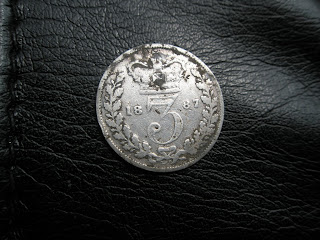
This is another one of the areas (photo below) where we have been cleaning back. You can see the possible demolition remains of another wall running diagonally across the corner. The roots here were a nightmare! We had to cut some of these with pruning scissors but some of the bigger ones had to be sawn out. I felt a bit guilty about the tree but he's a big boy and I'm sure he can cope with the ones left. Three of us were cleaning this section back and the area where the stone is starting to taper off is where poor Jas had moved over so I could work ... and also the area where I then flicked out a silver threepence piece!!!! (I am so sorry Jas! I know how annoying it is to be moved then the person who takes over finds something!!) More details of the coin in the finds section at the end!

This is the cleared out trench (below) from last year that we were working on yesterday. All of the protective covering is still down, I cant wait to take it off and see what is underneath! Obviously our edges need sorting out but our main aim was to get the bulk of the fill out to begin with, the edges couldn't be done until we found the sides! The area where the coin was found is the section off to the right in the front of the picture. Hopefully you can picture the layout a little better if I try and describe it until I draw a rough plan of everything for you. The deep trench that you can see at the back of the picture running off to the left is shown in the next photo along. They form a long T shape across our area.

This photo below is the other arm of the T shape which I told you about. You can see the sides cut nice and clean along this trench. This helps in the same way as cleaning the flat horizontal surfaces, you can see the different layers of soil, in which order they formed, from which direction soil was washed into ditches ... it is really important to keep these clean when you are trying to interpret formation processes or even work out where or what to dig next. You can see most of the team here hard at work!! (Apart from me who was bunking off taking pictures!)

 You may also be surprised to find out that this was how the coin came out of the ground. It hasn't been cleaned in any way for the photo. It was so clean I actually thought it might be a very thin, modern, five pence piece (this should also give you an indication of the coins size). This was our first small find from the site, and also my first small find too!!! (I have a big grin! ... yes still ... that's how sad I am!)
You may also be surprised to find out that this was how the coin came out of the ground. It hasn't been cleaned in any way for the photo. It was so clean I actually thought it might be a very thin, modern, five pence piece (this should also give you an indication of the coins size). This was our first small find from the site, and also my first small find too!!! (I have a big grin! ... yes still ... that's how sad I am!) These photos below are some of the bulk finds which have been found over the three days. They include various iron objects, animal remains and pottery
These photos below are some of the bulk finds which have been found over the three days. They include various iron objects, animal remains and pottery
The photo below is I believe a tooth from a sheep and a bone from a young sheep. (although I may be wrong, small bones are quite hard to identify as a particular animal unless you specialise in studying them) These were found in the fill of the trenches from last year.
 These finds below are again from the backfill, as you can see the bag has been labelled. Possibly a buckle and some kind of iron nail.
These finds below are again from the backfill, as you can see the bag has been labelled. Possibly a buckle and some kind of iron nail.
The next photo is of (mainly) pottery finds which can sometimes provide valuable dating evidence (although not on this particular occasion) There is also a small piece of bone.

Hopefully some more finds, walls and (fingers crossed) coins, tomorrow!!! I best get some sleep now as my muscles are wrecked from all of the shovelling!!







